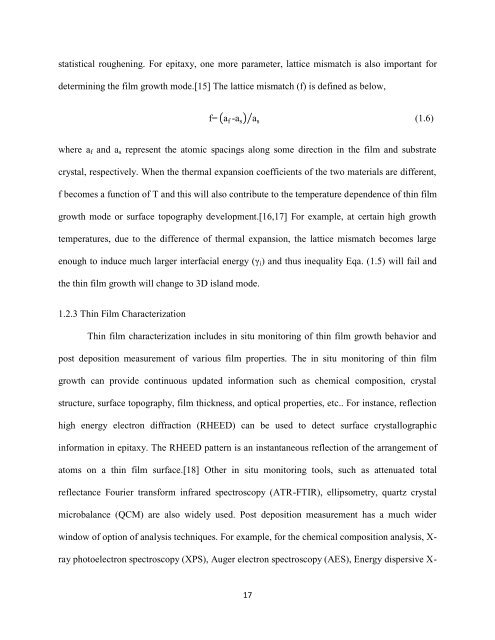CHEMICAL VAPOR DEPOSITION OF THIN FILM MATERIALS FOR ...
CHEMICAL VAPOR DEPOSITION OF THIN FILM MATERIALS FOR ...
CHEMICAL VAPOR DEPOSITION OF THIN FILM MATERIALS FOR ...
You also want an ePaper? Increase the reach of your titles
YUMPU automatically turns print PDFs into web optimized ePapers that Google loves.
statistical roughening. For epitaxy, one more parameter, lattice mismatch is also important for<br />
determining the film growth mode.[15] The lattice mismatch (f) is defined as below,<br />
f a f -a s a s<br />
where af and as represent the atomic spacings along some direction in the film and substrate<br />
crystal, respectively. When the thermal expansion coefficients of the two materials are different,<br />
f becomes a function of T and this will also contribute to the temperature dependence of thin film<br />
growth mode or surface topography development.[16,17] For example, at certain high growth<br />
temperatures, due to the difference of thermal expansion, the lattice mismatch becomes large<br />
enough to induce much larger interfacial energy (γi) and thus inequality Eqa. (1.5) will fail and<br />
the thin film growth will change to 3D island mode.<br />
1.2.3 Thin Film Characterization<br />
17<br />
(1.6)<br />
Thin film characterization includes in situ monitoring of thin film growth behavior and<br />
post deposition measurement of various film properties. The in situ monitoring of thin film<br />
growth can provide continuous updated information such as chemical composition, crystal<br />
structure, surface topography, film thickness, and optical properties, etc.. For instance, reflection<br />
high energy electron diffraction (RHEED) can be used to detect surface crystallographic<br />
information in epitaxy. The RHEED pattern is an instantaneous reflection of the arrangement of<br />
atoms on a thin film surface.[18] Other in situ monitoring tools, such as attenuated total<br />
reflectance Fourier transform infrared spectroscopy (ATR-FTIR), ellipsometry, quartz crystal<br />
microbalance (QCM) are also widely used. Post deposition measurement has a much wider<br />
window of option of analysis techniques. For example, for the chemical composition analysis, X-<br />
ray photoelectron spectroscopy (XPS), Auger electron spectroscopy (AES), Energy dispersive X-

















